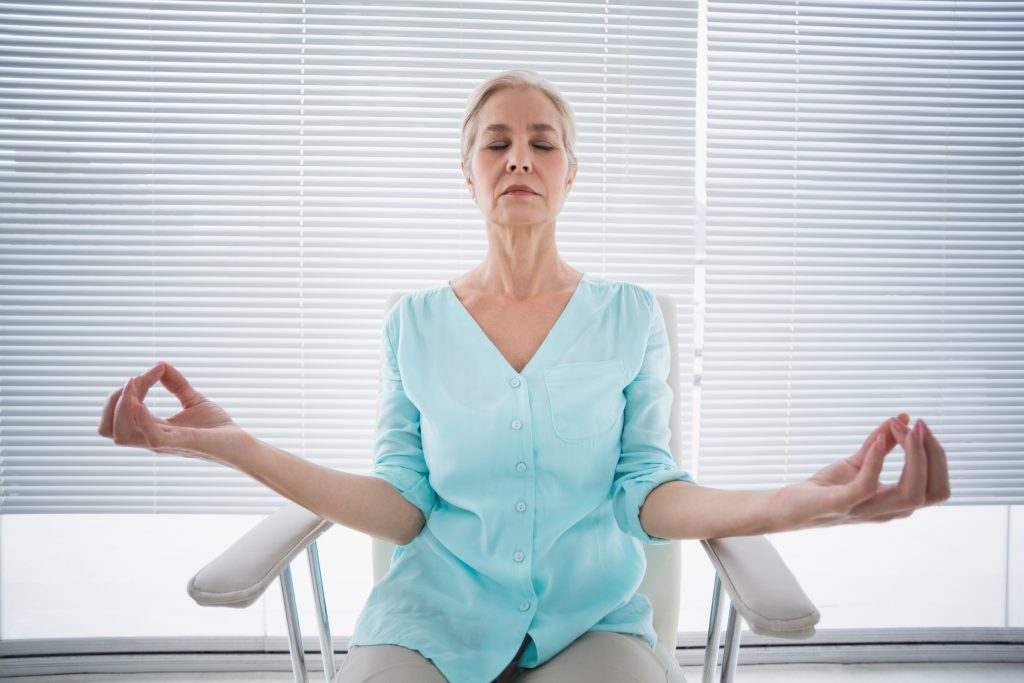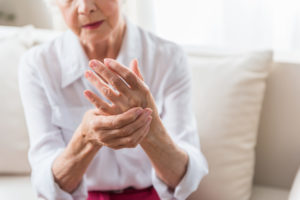
Yoga Increases Quality of Life for Older Adults with Osteoarthritis
Last updated on September 20th, 2022 at 10:00 am
In today’s blog post, freelance writer Anne Hamner explores the impact of chair yoga on osteoarthritis.
For the millions of older adults with osteoarthritis, yoga may be the answer to reducing pain and improving quality of life. Osteoarthritis is one of the most common health conditions affecting older adults in the U.S. This degenerative joint disease often affects the knees and hips leading to pain, difficulty climbing stairs and even walking. In some cases, it can lead to a total hip or knee replacement. This disease is likely to grow as the aging population and obesity rates increase.
A chair yoga study carried out by scientists at Florida Atlantic University and published in the Journal of the American Geriatrics Society, is the first to prove that this form of exercise can reduce pain and help avoid pharmacological treatments.1 Yoga also reduces “pain interference,” which is the extent to which pain interferes with one’s ability to carry out daily tasks, such as walking and bending.

In the study, researchers randomly assigned 131 elderly patients to either a chair yoga program or to a health education program. All participants attended 45-minute sessions twice weekly for a two-month period. Results showed that the yoga group experienced a greater reduction in pain as well as reduced pain interference with effects for the latter lasting for three months after the yoga program had ended. Those who attended the yoga sessions also reported less fatigue and had improved gait speed during the study period but not after, indicating that yoga should be undertaken regularly by those aiming to walk faster.
The American Arthritis Foundation recommends yoga to those suffering from joint pain. However, chair yoga is particularly useful as the chair provides balance, thus preventing falls. Many elderly patients are concerned about taking up a new activity such as yoga because they fear not being physically up to the task or getting injured. Chair yoga is ideal since it can be adapted to all fitness levels and the use of a chair lends a sense of safety and security.
Yoga is also a proven stress buster with numerous studies showing its ability to lower levels of stress hormone, cortisol. Yoga is an important complementary activity in many settings in which stress is a negative factor, including rehabilitation centers for addiction and in counselling sessions for patients suffering from Posttraumatic Stress Disorder. Elderly patients with osteoarthritis face their share of stress since a decline in physical functioning and balance can be depressing for those who used to lead a more active life. Yoga not only helps with strength and flexibility, but also increases a sense of calm and well-being.
With all of its benefits, yoga may soon become a crucial component in the treatment of pain in the elderly. One of the study researchers noted, “The potential impact of this study on public health is high, as this program provides an approach for keeping community-dwelling elders active even when they cannot participate in traditional exercise that challenges their balance.”
- J Am Geriatr Soc 65:592–597, 2017.
Share article:
Related Articles:



Blame It on the Rain: What to Do When Seasonal Weather Pains You




1 thought on “Yoga Increases Quality of Life for Older Adults with Osteoarthritis”
Yoga is a best ways to treat major diseases including osteoarthritis. it improves quality of life.